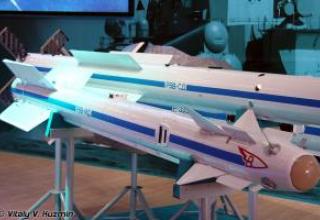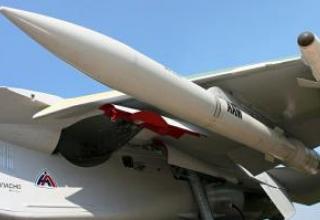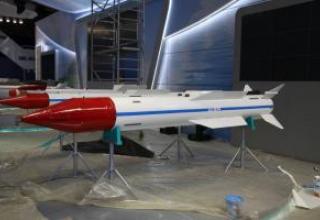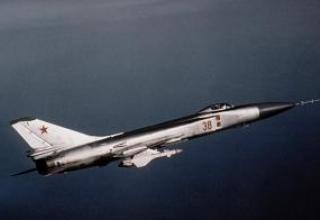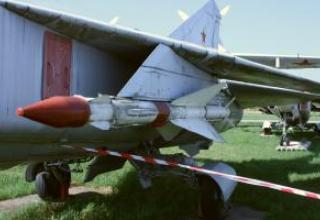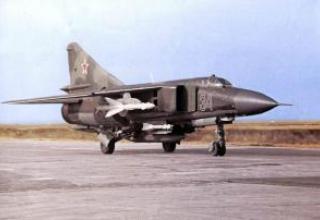The all-weather medium-range Derby aircraft missile with an active homing radar head is designed to intercept and destroy highly maneuverable manned and unmanned enemy vehicles day and night, from any direction, in the front and rear hemispheres, against the background of the underlying surface and with active radioelectronic counteraction.
The development of the Alto guided missile (ALC), later designated Derby, was initiated by the Israeli company Rafael in the early 1980s. A few years later, the South African company Kentron joined the program, which later developed a D-Darter missile for a similar purpose as part of this joint project. Derby was first officially presented at the Le Bourget Aerospace Show in June 2001. It was adopted for service by the Israeli Air Force in 2002. The new missile complemented the American AIM-120 AMRAAM, which is equipped with multifunctional F-15I fighters, as well as the most mass-produced aircraft of the Israeli Air Force F-16C/D. Smaller dimensions and masses allow the Derby to be used from lighter fighters such as F-5, Mirage and JAS-39 Gripen. It is also possible to equip the upgraded MiG-21 with this aircraft.
In addition to the Israeli Air Force, the new missile was purchased by the Chilean Air Force, where it is equipped with modernized fighters F-5E Tiger. In addition, in addition to missiles AIM-120 AMRAAM, it is planned to arm and F-16C/D aircraft purchased from the United States. Brazil is also considering purchasing these missiles to equip its upgraded F-5M aircraft. The Singapore Air Force is also considering a similar option for upgrading its F-5s. The Indian Navy re-equipped the Sea Harrier deck fighters with Derby missiles (in addition to new missiles, the planes received Israel's Elta EL/M-2032 multifunctional radar). The Derby was chosen to equip a promising light combat aircraft LCA Tejas of the Indian Air Force. Potential buyers are China, South Korea and the Philippines.
The Derby is used jointly with the Phiton-5 missile in the Israeli mobile anti-aircraft system Spider.
Composition:
The Derby rocket is made on the aerodynamic scheme "duck" and is largely unified with the short-range aviation missile Phiton-4. The Derby is equipped with a dual-mode solid propellant engine with a low-smoke mixed fuel charge, which is an upgraded version of the Phiton-4 rocket's ND-10 engine and differs from the prototype in its smaller dimensions and greater thrust. The engine is developed by MANOR (Rafael division).
The shrapnel-flag warhead and non-contact laser fuse are also borrowed from the Phiton-4 missile (see photo). The upgraded engine and advanced aerodynamic rudders with powerful drives provide Derby with high speed and maneuverability. According to advertising materials, the rocket can reach speeds up to 4M and can attack targets from any angle with large bearing and at significant ranges with its own overloads up to 50g. Ibid. asserts that in conducting close maneuverable air combat characteristics of the Derby is not inferior to the corresponding characteristics of the missile Phiton-3 and superior to the characteristics of the U.S. short-range missile AIM-9L Sidewinder.
The Derby guidance system is a combined missile guidance system that includes a command-inertial system and an active homing radar head (AHHF) developed by Israel Aircraft Industries MBT (see photo1,photo2 ). The signal processing system provides a high degree of protection against organized and natural interference, including on the background of the underlying surface. ARGSN is built on a modern element base and can be reprogrammed to meet customer requirements. It is difficult to draw conclusions about the technical perfection of ARGSN and Derby control system as technical data about them are not available in public publications.
The guidance system provides:
- LOAL - Lock On After Launch - applies for medium range and high angle of view shooting. In this mode, the missile on the initial section of the trajectory before the target is captured by the ARGSN is controlled by the inertial system of primary target designation, received from the aircraft carrier radar or helmet target designation system. The presence of a radio command line receiver on board the missile allows for correction and redirection of the trajectory, including targets with a small reflective surface. ARGSN provides target selection and the possibility of its re-capture at loss.
- LOBL - Lock On Before Launch is used in close combat conditions. In this mode, the inertial control system is not activated.
Derby can be launched from the same aircraft launchers as the Phiton-4. It is also possible to adapt the missile to other types of launchers.
Characteristics:
| Maximum flight range, km | 50 |
| Maximum flight speed | 4М |
| Dimensions, mm: - length - diameter - wingspan |
3620 160 640 |
| Start weight, kg | 118 |
Testing:
As of 01.01.1950, the factory batch of 230 shells was completed and sent to the Pavlograd test site.
In November 1949, pre-factory tests of 34 shells were carried out together with the fuse B-377 during which cases of missiles were revealed.
Special tests carried out to determine the causes of deficits showed that the most probable cause was an increased release of unburned reactive charge particles at the end of the active section of the trajectory.
In order to eliminate this phenomenon, in December 1949 a bench-top refinement of the engine was started with regard to aperture enhancement and ensuring that the powder charge was fixed in the chamber. After the end of the bench work and experimental firing for checking the reinforced aperture, the factory batch of projectiles was to be equipped with modified apertures on site and presented for factory tests in February 1950.
Sources:
- DERBY - Beyond Visual Range Air-to-Air Missile
- Ильин В. "Зарубежные ракеты «ВОЗДУХ-ВОЗДУХ»" Арсенал, N2, 2008 ( http://www.rusarm.com/ )
- Ракетная техника на выставке DEFEXPO-2010. Фоторепортаж В.В. Ерохина (г. Тула)


